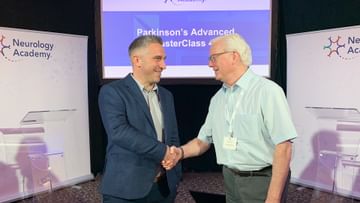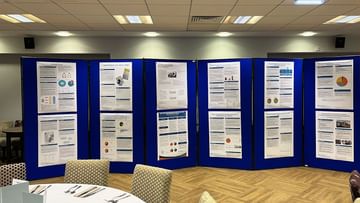Lessons from Alzheimer’s disease therapeutics
Event reportsOur seventh Parkinson's Cutting Edge Science conference took place on 19th March 2024 in Birmingham and was chaired by Prof Emily Henderson and Dr Neil Archibald. You can read an overview of the entire event here.
This write up is one of a series covering each session in detail for those who were unable to attend, or want to reflect on what they heard. Read more session write ups here.
Like Parkinson’s disease, Alzheimer’s has been dogged with the challenge of developing effective disease modifying therapies (DMTs) for decades. Yet with the first wave of agents now being firmly on the horizon, things are about to change.
Dr David Nesbitt, neurology consultant at Newcastle Upon Tyne Hospitals NHS Foundation Trust, said this raised new challenges, such as identifying the patients who stand to benefit from the therapies and building the infrastructure needed to support their delivery and monitoring.
Such issues, he explained, were likely to be reflected in Parkinson’s as and when DMTs for the condition become available.
The importance of biomarkers
The most common cause of dementia, Alzheimer's, is characterised by the accumulation of amyloid-beta (Aβ) plaques and tau tangles that lead to neuronal loss and cognitive decline.
Similar to Parkinson’s, it tends to be diagnosed after clinical symptoms appear, yet the pathology of both conditions is present decades beforehand.
“In the early stages of Alzheimer’s there is mild cognitive impairment (MCI) and then gradually, the disease progresses to dementia. But many years before that, you can pick up subtle changes that suggest damage is occurring,” said Dr Nesbitt. “If you look at cerebral spinal fluid (CSF), levels of beta-amyloid 42, for example, start to rise before people become symptomatic. There are changes on PET scans, and MRI structural changes.”
The Alzheimer’s field has developed a standardised process, the Amyloid, Tau, Neurodegeneration (ATN) framework to evaluate the biomarkers of disease. It includes the measurement of amyloid and tau pathology, via CSF, serum and imaging biomarkers, and the neurodegeneration process using clinical scores.
This is important for accurate diagnosis, he said, as well as ensuring only people with Alzheimer’s pathology are recruited into clinical trials, initiated on treatment, and are able to be monitored for response.
It is not, however, without its challenges. PET and MRI is expensive, and CSF testing is invasive compared to serum or plasma-based screening. “While blood-based biomarkers are probably the best way to measure these things, for simplicity and ubiquity, they are not very specific at the moment,” Dr Nesbitt added.

Anti-amyloid antibodies
Again similar to Parkinson’s, Alzheimer’s treatment is currently “very much focused on symptomatic control”. “We have cholinesterase inhibitors and NMDA antagonists, but they do not alter the course of the disease and only offer a modest benefit to patients,” said Dr Nesbitt.
Recent years have seen the emergence of anti-amyloid antibodies (aABs), such as aducanumab, lecanemab, and donanemab. Dr Nesbitt explained that the accumulation of soluble and insoluble Aβ may initiate or potentiate the pathologic processes of Alzheimer’s disease. aABs bind with Aβ protofibrils and plaques, breaking them down, and there is some evidence to suggest this can slow progression.
Aducanumab measured reduction of cognitive decline as their primary endpoint, and despite demonstrating high amyloid clearance, they were halted early based on results from a futility analysis of interim data.[1] European and UK regulators declined to approve it, on the basis that it did not deliver a meaningful clinical benefit in terms of reducing the pace of cognitive decline.
Lecanemab has “shown slightly more promise”, Dr Nesbitt went on, showing a significant reduction in amyloid levels in the brain when compared to placebo, down to normal in many cases. [2] There was also a significant reduction in the worsening of cognitive function,2 and such results have also been recorded in trials of donanemab.[3]
“These are not spectacular results, but they're definitely the most significant we've seen in the field,” he said, adding that they represented hope for people living with Alzheimer's disease.
However, there are also safety concerns associated with aAB treatment, primarily the risk of amyloid-related imaging abnormalities (ARIA), or micro bleeds on the brain. Dr Nesbit explained that once broken down, the soluble Aβ fragments can be transported through the blood vessels and cause local inflammatory responses. This can lead to headaches, seizures, and significant change on MRI.[4]
It is usually mild and can be asymptomatic, but ARIA can be fatal in some people. Dosage and APOE-e4 carrier status are the most important risk factors, as well as the presence of baseline micro-hemorrhages.[4]
Implementation
Developing the therapies is only part of the equation, and significant resources will be needed to implement them into clinical practice.
Healthcare providers will need to reorganise diagnostic services such as memory clinics, and provide genetic counselling for those with APO-e4 positivity. They will need to build the infrastructure required to deliver two or four weekly infusions, and regular clinical and MRI monitoring. What’s more, patients who develop ARIA will need access to specialists and escalation facilities, such as intensive care units. “This is not going to be cheap,” said Dr Nesbitt, adding that the Parkinson’s community may face similar challenges in the coming years if current trials of DMTs are successful.
“Looking forward, there are lots of challenges in the future, but they are the kind of challenges we want,” concluded Dr Nesbit. “It is an exciting time for researchers, clinicians, patients and society.”
Mind. (2024). Biogen terminates phase 4 efficacy study of aducanumab. Available at: https://mind.uci.edu/biogen-te.... Accessed: 28 March 2024.
Van Dyck, C. H., Swanson, C. J., et al. (2023). Lecanemab in early Alzheimer’s disease. New England Journal of Medicine, 388(1), 9-21.
Sims, J. R., Zimmer, J. A., et al. (2023). Donanemab in early symptomatic Alzheimer disease: the TRAILBLAZER-ALZ 2 randomized clinical trial. Jama, 330(6), 512-527.
Hampel, H., Elhage, A., et al. (2023). Amyloid-related imaging abnormalities (ARIA): radiological, biological and clinical characteristics. Brain, 146(11), 4414-4424.

This meeting is designed and delivered by the Parkinson’s Academy and sponsored by BIAL Pharma. The sponsor has had no input into the educational content of this meeting.
Related articles
'The things you can't get from the books'
Parkinson's Academy, our original and longest running Academy, houses 23 years of inspirational projects, resources, and evidence for improving outcomes for people with Parkinson's. The Academy has a truly collegiate feel and prides itself on delivering 'the things you can't get from books' - a practical learning model which inspires all Neurology Academy courses.






